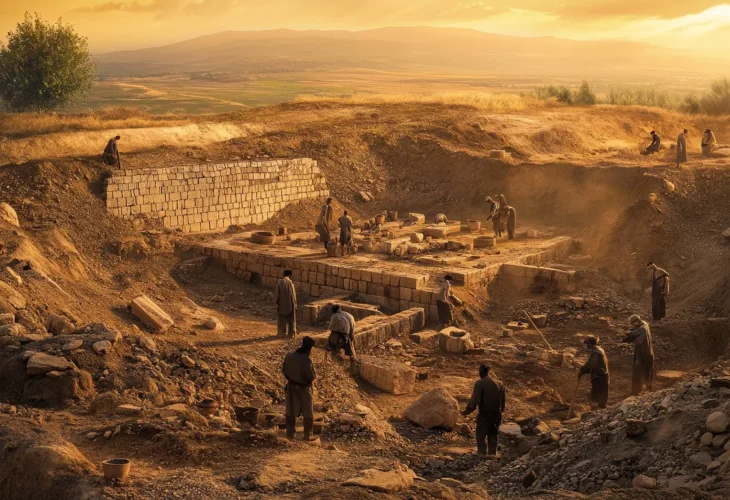The Mystery of Lachish: Unearthing a 3,300-Year-Old Biblical Tale
Deep within the ancient ruins of Tel Lachish, numerous artifacts help reconstruct the city's history from the Canaanite to the Israelite periods, up until its destruction.

James Leslie Starkey was a pilot in His Majesty's Royal Air Force. At the age of 28, he met the archaeologist Flinders Petrie, who taught him to read hieroglyphs, igniting a passion for research. Starkey decided to become an archaeologist. Several years later, he led a team excavating "Tel ed-Duweir," which Albright hypothesized to be the biblical Lachish. In the early stages of the excavation, a destruction layer from about 3,300 years ago was found, containing 1,500 skulls. Starkey speculated that this was the destruction layer from the time of Joshua, as mentioned in the Bible. The King of Lachish went to battle against the Gibeonites, allies of Israel, and Joshua destroyed his city, capturing him in a cave near Makkedah.
Starkey never saw the publication or analysis of his findings because he was murdered by Arab assassins seeking revenge against the British. While traveling from Tel Lachish to the Rockefeller Museum for an exhibition of finds from Tel Lachish, he was shot by Arabs near Beit Guvrin, south of Hebron. Yet, many others continued his work and confirmed that, contrary to earlier theories, Tel ed-Duweir is indeed Lachish.
Lachish was known to researchers not only from biblical descriptions but also from the depictions in the palace of Sennacherib, uncovered a century earlier by the French explorer Austen Layard in his excavations of Nineveh. Sennacherib, King of Assyria, who failed to capture Jerusalem on his campaign in Judah, had previously conquered Lachish. He dedicated an entire wall in his palace to this achievement. The reliefs depict the siege of the city, with Assyrian soldiers breaching the wall and Jews—men, women, and children—being exiled. The women are shown wearing headscarves, the Jews with fringes, and the children wearing yarmulkes, just like in the pictures... One relief shows the vast plunder, with an inscription in Assyrian: "Sennacherib, King of the World, King of Assyria, sat on the throne, and the loot of Lachish passed before him," indicating the city's significance to Sennacherib.
In the depths of Tel Lachish, many artifacts were found that allow us to reconstruct the city's appearance and operations, at least partially, during the Canaanite period, the Israelite period, and up to its destruction. Various inscriptions were found, from a comb made of ivory engraved with "May this tusk remove lice from the hair and beard"... (tusk - elephant ivory), to a bowl inscribed with "honey" (presumably). But the crown jewel of the findings are the "Lachish Letters," a series of inscriptions documenting the destruction of the city by the Assyrians from a Jewish perspective.
The letters were found in the city gatehouse, within a layer of ash. They were inscribed on pieces of pottery, and the fire that consumed the city destroyed the container or the place where they were held, leaving them buried in the ruins for millennia. There are 22 letters, most exchanged between Yaush, the military commander in Lachish, and Hosiah, a Jewish military officer in another nearby fortress, likely Azekah. The standard opening of the letters is "To my lord Yaush, may Hashem make my lord hear good tidings of peace." In one letter, Hoseiah is offended by Yaush's suggestion that he is illiterate and that only his servants read for him: "May Hashem make my lord hear tidings of peace and good news, and now please open your servant's ear to the letter you sent to your servant yesterday, for your servant's heart is very sore from your message, and thus my lord said: 'You do not know how to read a letter,' by Hashem if I have tried, I can read any letter that comes to me." Clearly, Officer Hoseiah could read and write quite well.
At the end of this letter, an intriguing note is included: "Your servant was informed that the military officer Keniah the son of El-natan went down to Egypt and that Hodiah the son of Ahijah and his men were sent to bring him back from there." Why did the military officer go to Egypt? The next letter reveals: he went to arrest a prophet, "the words of the prophet are not good to ease hands." Just as the kings opposed Jeremiah and imprisoned him during the destruction (under the pretext of easing hands: "Then the officials said to the king, let this man be put to death, for thus he eases the hands of the military," Jeremiah 38), so, too, before the destruction of Lachish, the military officers attempted to silence a prophet who likely prophesied the destruction. Who was this prophet?
It may have been the prophet Uriah, described in the Book of Jeremiah, Chapter 26: "There was a man prophesying in the name of Hashem, Uriah the son of Shemaiah from Kiriath-jearim, and he prophesied against this city and this land according to all the words of Jeremiah. And King Jehoiakim and all his mighty men and all the officials heard his words and sought to put him to death. Uriah heard and was afraid, and fled to Egypt. King Jehoiakim sent men to Egypt, El-natan the son of Achbor and men with him to Egypt. They brought Uriah out of Egypt and brought him to King Jehoiakim who struck him with the sword and threw his body into the graves of the common people." The prophet Uriah met a sad end, executed by the king's men.
There is a name difference: in the prophecy, it is El-natan the son of Achbor, while the letter says "Kaniah the son of El-natan." However, it is possible that they are referring to the same person, and the letter writer made a small error or heard it inaccurately.
This is one of the fascinating letters among dozens of inscriptions found in Lachish, depicting its varied historical periods.

